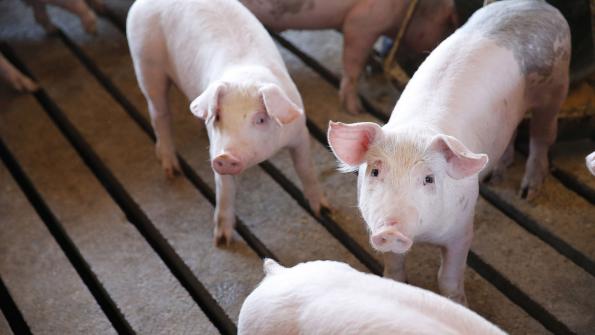The combined use of direct and indirect tests will help to better understand the dynamics of M. hyorhinis infections in swine populations.
September 3, 2019

By Luis Giménez-Lirola, Korakrit Poonsuk and Bailey Arruda, Iowa State University
Although Mycoplasma hyorhinis is considered a commensal microorganism (i.e., detected by polymerase chain reaction in the absence of clinical disease) of the upper respiratory tract and tonsils of swine, it can cause disease resulting in lameness and loss of condition under specific conditions through mechanisms that are poorly understood. The Iowa State University Veterinary Diagnostic Laboratory accounted for an average of 26% of Mycoplasma-associated arthritis and lameness cases between 2013 and 2014, with an increasing frequency over the last several years.
Recently, M. hyorhinis-associated disease has emerged as an important contributor to mortality in nursery pigs [1]. M. hyorhinis colonization is not uncommon and has been detected in nearly every production system, with variable between and within herd prevalence that varies by age and among production systems [2]. Therefore, in the absence of clinical signs, detection must be interpreted with caution.
A diagnosis of M. hyorhinis-associated disease is made based on history, clinical signs, typical gross and microscopic lesions, and isolation of M. hyorhinis by culture in specific media (i.e., Friis) from affected tissues (e.g., fibrin from serous membranes, synovial tissue or joint fluid) or, more commonly, detection of M. hyorhinis by PCR in these same sample types.
Due to the increased frequency of diagnosis and poor response to treatment in a subset of animals, there is an immediate need for antemortem diagnostic tools that are able to inform intervention strategies intended to prevent M. hyorhinis-associated disease. The ISU-VDL has recently developed a novel M. hyorhinis indirect enzyme-linked immunosorbent assay based on a recombinant chimeric made of variable lipoproteins specific (unique) to M. hyorhinis that allow for early and differential detection of M. hyorhinis infections with no cross-reactivity with other swine mycoplasmas.
The progressions of M. hyorhinis clinical disease (lameness and loss of condition) were evaluated in relation to the kinetics of the isotype-specific (IgG, IgA) antibody response in serum and bacterial shedding (PCR) in oral fluids using a cesarean-derived, colostrum-deprived pig model.
As Figure 1 shows, bacterial DNA was detected in oral fluids throughout the study (DPI 56) suggesting that oral fluids are a suitable specimen to determine herd status of colonization. IgA antibody was first detected at DPI 7 concomitantly with the onset of clinical signs, with both IgA and IgG detected in all serum samples collected after DPI 14 through the end of the study.

The identification of subclinically infected animals and the monitoring of disease progression in clinically affected herds is important for disease surveillance and management. The combined use of direct (PCR) and indirect (Vlp ELISA) tests will help to better understand the dynamics of M. hyorhinis infections in swine populations. These antemortem tools could be used for intervention timing and evaluation of interventions to improve the control of M. hyorhinis-associated disease.
This work was funded by the National Pork Board.
References
1. Clavijo MJ, Murray D, Oliveira S, Rovira A. Infection dynamics of Mycoplasma hyorhinis in three commercial pig populations. Vet. Record. doi: 10.1136/vr.104064.
2. Leuwerke B. 2009. Mycoplasma hyorhinis-Field experiences in diagnosis and control.
Sources: Luis Giménez-Lirola, Korakrit Poonsuk and Bailey Arruda, who are solely responsible for the information provided, and wholly own the information. Informa Business Media and all its subsidiaries are not responsible for any of the content contained in this information asset.
You May Also Like


